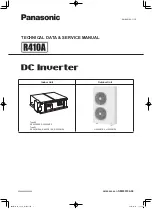
A - 2
1. Electric Shock Prevention
2. Fire Prevention
SAFETY INSTRUCTIONS
WARNING
While power is on or when the inverter is running, do not open the front cover.
You may get an electric shock.
Do not run the inverter with the front cover or wiring cover removed. Otherwise,
you may access the exposed high-voltage terminals or the charging part of the
circuitry and get an electric shock.
If power is off, do not remove the front cover except for wiring or periodic
inspection. You may access the charged inverter circuits and get an electric shock.
Before starting wiring or inspection, check to make sure that the inverter power
indicator lamp is off, wait for at least 10 minutes after the power supply has been
switched off, and check that there are no residual voltage using a tester or the
like. The capacitor is charged with high voltage for some time after power off and
it is dangerous.
This inverter must be grounded. Grounding must conform to the requirements of
national and local safety regulations and electrical codes. (JIS, NEC section 250,
IEC 536 class 1 and other applicable standards)
Any person who is involved in the wiring or inspection of this equipment should
be fully competent to do the work.
Always install the inverter before wiring. Otherwise, you may get an electric
shock or be injured.
Operate the switches and potentiometers with dry hands to prevent an electric
shock.
Do not subject the cables to scratches, excessive stress, heavy loads or
pinching. Otherwise, you may get an electric shock.
Do not change the cooling fan while power is on.
It is dangerous to change the cooling fan while power is on.
CAUTION
Mount the inverter and brake resistor on an incombustible surface. Installing the
inverter directly on or near a combustible surface could lead to a fire.
If the inverter has become faulty, switch off the inverter power. A continuous flow
of large current could cause a fire.
When a brake resistor is used, use an alarm signal to switch power off.
Otherwise, the brake resistor may excessively overheat due to damage of the
brake transistor and such, causing a fire.
Do not connect a resistor directly to the DC terminals P(+), N(-). This could cause
a fire.
M4500E.book 2 ページ 2005年2月22日 火曜日 午後5時7分
Summary of Contents for M4000E series
Page 11: ...MEMO ...
Page 23: ...12 MEMO ...
Page 55: ...44 MEMO ...
Page 173: ...162 MEMO ...
Page 199: ...188 MEMO ...




































